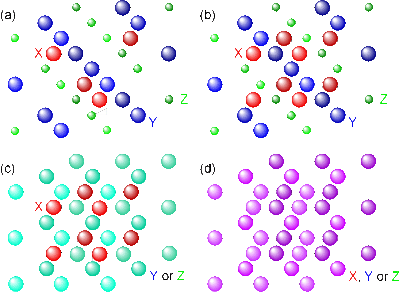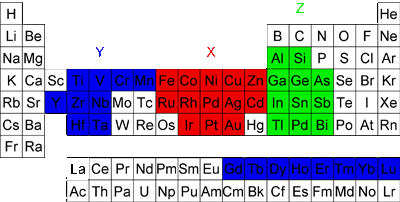Last updated: 27/12/2018
Heusler Alloys
 Among the four proposed half-metallic ferromagnets, the Heusler alloys holds the greatest potential to realise the half-metallicity at RT due to their lattice constant matching with the III-V semiconductors, high Curie temperature TC above RT and large bandgap at EF in general. The Heusler alloys are categorised into two distinct groups by their crystalline structures; half Heusler alloys with the form of XYZ in the C1b structure and full Heusler alloys with the form of X2YZ in the L21 structure as schematically drawn in the right figures (a) and (b), respectively, where X and Y atoms are transition metals, while Z is either a semiconductor or a non-magnetic metal (see the left figure below). The unit cell of the L21 structure consists of four face-centered cubic (fcc) sublattices, while that of the C1b structure is formed by removing one of the X sites. In the Heusler alloys, the half-metallicity is known to be fragile against atomic disorder. For the L21 structure, when the Y and Z atoms replace their sites (Y-Z disorder) and eventually occupy their sites absolutely at random, the alloy transforms into the B2 structure [the right top figure (c)]. In addition, X-Y and X-Z disorder finally forms the A2 structure [the right top figure (d)].
Among the four proposed half-metallic ferromagnets, the Heusler alloys holds the greatest potential to realise the half-metallicity at RT due to their lattice constant matching with the III-V semiconductors, high Curie temperature TC above RT and large bandgap at EF in general. The Heusler alloys are categorised into two distinct groups by their crystalline structures; half Heusler alloys with the form of XYZ in the C1b structure and full Heusler alloys with the form of X2YZ in the L21 structure as schematically drawn in the right figures (a) and (b), respectively, where X and Y atoms are transition metals, while Z is either a semiconductor or a non-magnetic metal (see the left figure below). The unit cell of the L21 structure consists of four face-centered cubic (fcc) sublattices, while that of the C1b structure is formed by removing one of the X sites. In the Heusler alloys, the half-metallicity is known to be fragile against atomic disorder. For the L21 structure, when the Y and Z atoms replace their sites (Y-Z disorder) and eventually occupy their sites absolutely at random, the alloy transforms into the B2 structure [the right top figure (c)]. In addition, X-Y and X-Z disorder finally forms the A2 structure [the right top figure (d)].
 The origin of the bandgap in the Heusler alloys is attributed to the strong d-band hybridization of the two transition metals X and Y. Total spin magnetic moments per formula unit Mt have been reported to follow the generalised Slater-Pauling curve by Galanakis et al., which is represented as Mt=Zt-18 (half Heusler) and Zt-24 (full Heusler), where Zt is the total number of valence band electrons. This behavior enables us to preferentially control the magnetic properties, the spin DOS at EF in particular, continuously by substituting the Y atoms with the other transition metals as listed in the left figure. Even though there are over 2400 possible combinations to form Heusler alloys, there are about a few tens of alloys reported to become the HMFs according to theoretical calculations on this point.
The origin of the bandgap in the Heusler alloys is attributed to the strong d-band hybridization of the two transition metals X and Y. Total spin magnetic moments per formula unit Mt have been reported to follow the generalised Slater-Pauling curve by Galanakis et al., which is represented as Mt=Zt-18 (half Heusler) and Zt-24 (full Heusler), where Zt is the total number of valence band electrons. This behavior enables us to preferentially control the magnetic properties, the spin DOS at EF in particular, continuously by substituting the Y atoms with the other transition metals as listed in the left figure. Even though there are over 2400 possible combinations to form Heusler alloys, there are about a few tens of alloys reported to become the HMFs according to theoretical calculations on this point.
For further reading < Half-Metals Back to the Top Half-Metal Research >





